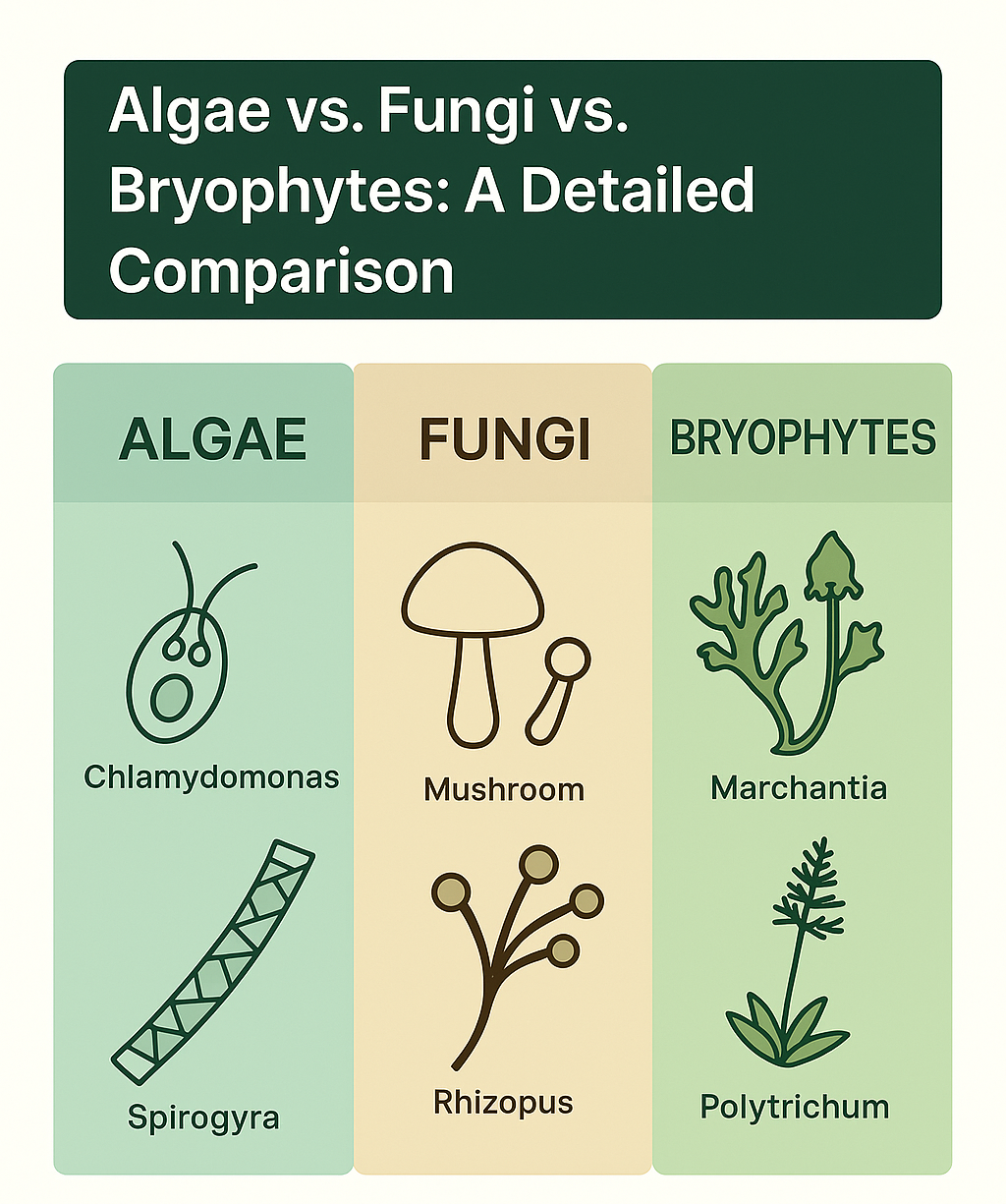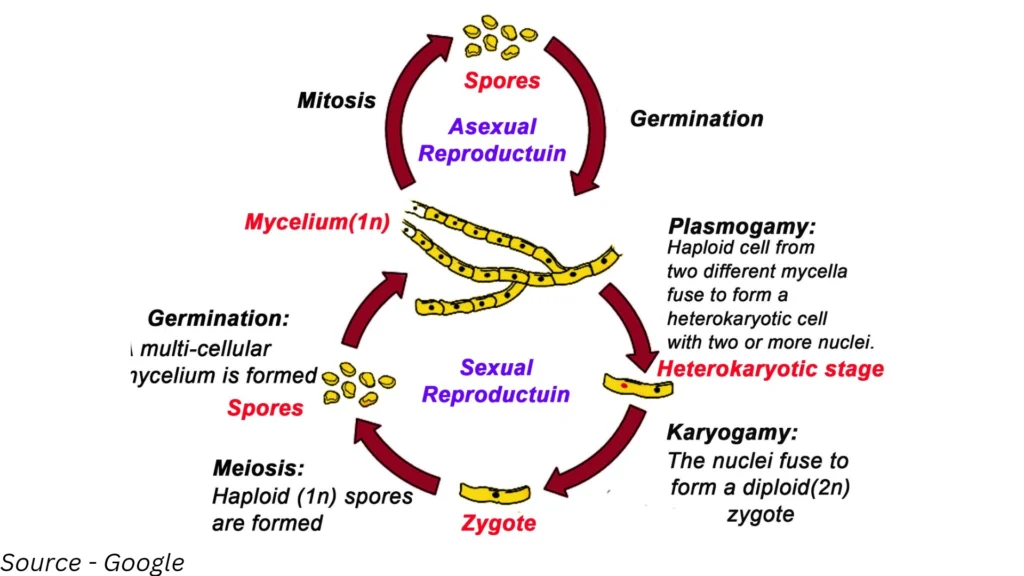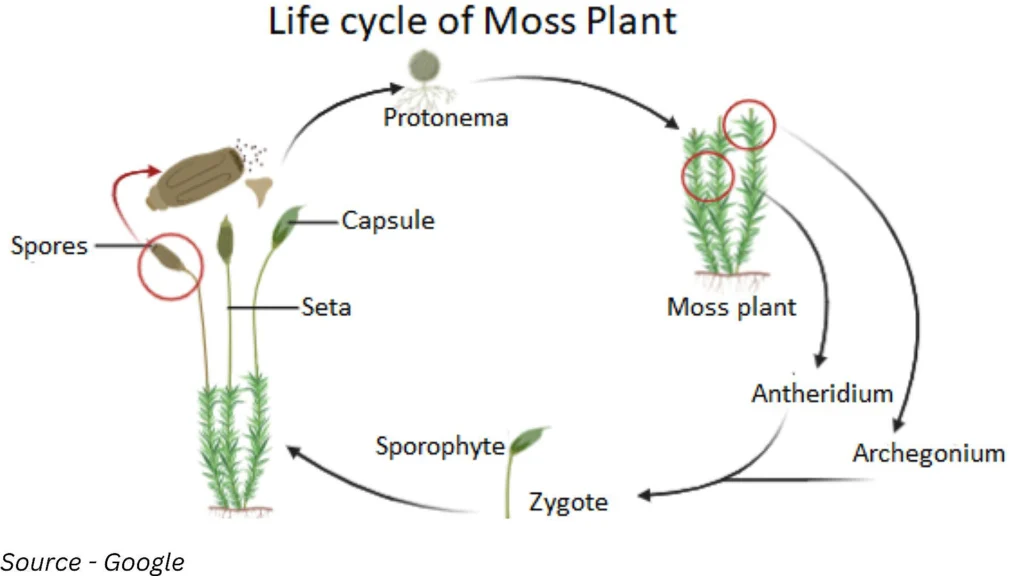Algae vs. Fungi vs. Bryophytes: A Detailed Comparison

In the diverse world of biological organisms, algae, fungi, and bryophytes represent three unique and fascinating groups with distinct characteristics. While algae thrive in aquatic environments, performing photosynthesis and producing oxygen, fungi play a crucial role as decomposers in terrestrial ecosystems. Bryophytes, including mosses, liverworts, and hornworts, occupy moist, shaded habitats and are important for soil formation and moisture retention. This article provides a detailed comparison of these three groups, highlighting their key differences in structure, reproduction, habitat, and ecological roles.
1. Cellular Organization
Algae
Algae are a diverse group of photosynthetic organisms, ranging from unicellular forms like Chlamydomonas to large multicellular seaweeds. They can also form colonies and filaments, providing structural variety. Despite their simplicity, algae are incredibly efficient at converting sunlight into energy through photosynthesis.
Fungi
Fungi primarily exist as multicellular organisms, with structures composed of hyphae that form a mycelium network. However, they also include unicellular forms such as yeasts. Fungi exhibit a complex cellular organization that supports their role as decomposers, breaking down organic matter.
Bryophytes
Bryophytes, including mosses, liverworts, and hornworts, are always multicellular. They form simple plant bodies without true roots, stems, or leaves, but they have structures that function similarly. Bryophytes are vital in ecosystems for soil formation and moisture retention.

2. Nutrition
Algae
Algae are autotrophic organisms that perform photosynthesis using chlorophyll. As primary producers in aquatic ecosystems, they form the base of the food chain and produce oxygen, supporting a diverse array of marine life.
Fungi
Fungi are heterotrophic and obtain nutrients through absorption. They decompose organic matter, making them essential for nutrient cycling. Some fungi form symbiotic relationships, such as mycorrhizae with plant roots, aiding in nutrient absorption.
Bryophyte
Bryophytes are autotrophic, performing photosynthesis using chlorophyll. They thrive in moist environments, contributing to the ecosystem by stabilizing soil and retaining moisture.
3. Reproduction
Algae
Algae reproduce both sexually and asexually. In sexual reproduction, the fusion of gametes occurs, which can be isogamous (gametes of similar size and shape), anisogamous (gametes of different sizes), or oogamous (large non-motile egg and small motile sperm). Asexual reproduction often involves the formation of spores or fragmentation, where parts of the algae break off and grow into new individuals.
Fungi
Fungi also reproduce both sexually and asexually. Sexual reproduction involves the fusion of hyphae (plasmogamy), followed by the formation of spores. This process can create genetic diversity within fungal populations. Asexual reproduction can occur through the production of spores or budding, as seen in yeasts, where new cells form from the parent cell.

Bryophyte
Bryophytes reproduce both sexually and asexually. In sexual reproduction, bryophytes produce gametes in specialized structures called antheridia (male) and archegonia (female). The fusion of these gametes leads to the formation of a sporophyte, which produces spores. Asexual reproduction occurs through fragmentation or specialized structures like gemmae, which are small clumps of cells that can grow into new individuals.

4. Habitat
Algae
Algae are primarily found in aquatic environments, including freshwater and marine ecosystems. They thrive in various water bodies, from small ponds to vast oceans. Some species of algae can also be found in moist terrestrial habitats, such as damp soil, tree bark, and rocks, adapting to diverse environmental conditions.
Fungi
Fungi are mainly terrestrial organisms. They thrive in soil, decomposing organic matter like fallen leaves and dead trees. Fungi also form symbiotic relationships with plants (e.g., mycorrhizae, lichens). Some fungi can be found in aquatic environments, demonstrating their adaptability to different habitats.
Bryophytes
Bryophytes prefer moist, shaded environments such as forests, bogs, and wetlands. They often grow on soil, rocks, and tree trunks in these habitats. Bryophytes can tolerate desiccation and cold, making them resilient and able to survive in various environments, including harsh climates.
5. Cell Wall Composition
Algae
Algal cell walls are primarily composed of cellulose, a polysaccharide that provides structural support. However, some groups of algae, like diatoms, have cell walls made of silica, which gives them additional rigidity and protection. This unique composition allows diatoms to withstand various environmental conditions.
Fungi
Fungal cell walls are mainly made of chitin, a nitrogen-containing polysaccharide. Chitin gives fungal cell walls their rigidity and resistance to environmental stress. This composition is quite different from that of plants and algae, reflecting fungi’s distinct evolutionary path.
Bryophytes
Bryophytes have cell walls composed mainly of cellulose, similar to higher plants. This similarity in cell wall composition reflects their evolutionary relationship with vascular plants, highlighting the shared characteristics within the plant kingdom.
6. Reserve Food Material
Reserve food refers to the stored nutrients within an organism that can be utilized when external sources of energy are scarce or unavailable. These stored materials provide a vital source of energy and building blocks for cellular processes, growth, and development during periods when photosynthesis or nutrient uptake is not sufficient to meet the organism’s metabolic needs.
Algae
Reserve food refers to the stored nutrients within an organism that can be utilized when external sources of energy are scarce or unavailable. These stored materials provide a vital source of energy and building blocks for cellular processes, growth, and development during periods when photosynthesis or nutrient uptake is not sufficient to meet the organism’s metabolic needs.
Algae store energy in various forms depending on the group. For example:
- Chlorophyceae (Green Algae): Starch
- Phaeophyceae (Brown Algae): Laminarin and Mannitol
- Rhodophyceae (Red Algae): Floridean Starch
- Diatoms (Bacillariophyceae): Chrysolaminarin and Oil
- Dinoflagellates: Starch and Lipids
- Euglenophyceae: Paramylon
Fungi
In fungi, the primary reserve food material is glycogen, which is a polysaccharide similar to starch in plants. Additionally, fungi can store lipids and, in some cases, mannitol (a type of sugar alcohol). These reserves are crucial for their survival, providing energy and carbon sources when external nutrients are limited.
Bryophytes
In bryophytes, the primary reserve food material is starch. Starch is a polysaccharide composed of glucose units, which serves as an energy storage molecule. Bryophytes store starch in their chloroplasts and other plastids, which can be broken down into glucose to provide energy during periods when photosynthesis is not possible, such as at night or during unfavorable environmental conditions.
7. Ecological Roles
Algae
Algae play a crucial role as primary producers in aquatic ecosystems. They generate oxygen and form the base of the food web, supporting a wide range of marine life. Additionally, algae are used in various industries, including food, pharmaceuticals, and biofuels.
Fungi
Fungi are essential decomposers in terrestrial ecosystems, breaking down organic matter and recycling nutrients. They form symbiotic relationships with plants (mycorrhizae) and animals (lichens), contributing to ecosystem stability and nutrient cycling.
Bryophytes
Bryophytes are important for soil formation and moisture retention. They stabilize soil in moist environments, preventing erosion, and provide habitat for various microorganisms. Bryophytes also play a role in nutrient cycling and can indicate environmental changes due to their sensitivity to pollutants.
Comparative Characteristics chart
| Characteristics | Algae | Fungi | Bryophyte |
|---|---|---|---|
| Habitat | Aquatic (freshwater and marine), moist terrestrial | Mainly terrestrial, in moist and decaying organic matter | Terrestrial, moist, shaded environments |
| Photosynthesis | Yes, contain chlorophyll | Yes, contain chlorophyll | Yes, contain chlorophyll |
| Cell Wall Composition | Cellulose, some with silica or calcium carbonate | Chitin | Cellulose |
| Structure | Simple, unicellular or multicellular without true tissues | Complex hyphal network (mycelium), fruiting bodies | Simple, non-vascular, with rhizoids instead of roots |
| Reproduction | Asexual (binary fission, fragmentation, spores) and sexual | Asexual (conidia, sporangia, budding) and sexual (spores) | Asexual (conidia, sporangia, budding) and sexual (spores) |
| Pigments | Chlorophylls, carotenoids, phycobilins | No pigments for photosynthesis | Chlorophyll |
| Nutrition | Autotrophic (photosynthetic) | Heterotrophic (saprophytic, parasitic, mutualistic) | Autotrophic (photosynthetic) |
| Vascular Tissues | Absent | Absent | Absent |
| Life Cycle Dominance | Varied, can be diploid or haploid dominant | Haploid dominant | Gametophyte (haploid) dominant |
| Symbiotic Relationships | Some form symbiotic relationships (e.g., lichens) | Many form symbiotic relationships (e.g., mycorrhizae, lichens) | Some form symbiotic relationships (e.g., with fungi) |
| Mobility of Gametes | Some have motile gametes | Non-motile gametes | Motile sperm |
| Importance in Ecosystem | Primary producers, oxygen production | Decomposers, nutrient cycling | Soil formation, moisture retention |
| Economic Importance | Food, biofuels, pharmaceuticals | Antibiotics, food (mushrooms, yeast), bioremediation | Ecological indicators, horticulture |
| Examples | Green algae (Chlorophyta), brown algae (Phaeophyta), red algae (Rhodophyta) | Mushrooms, yeasts, molds | Mosses (Bryophyta), liverworts (Marchantiophyta), hornworts (Anthocerotophyta) |
What are the main differences between algae, fungi, and bryophytes?
Algae are primarily aquatic, photosynthetic organisms; fungi are decomposers in terrestrial ecosystems, and bryophytes are simple plants found in moist, shaded environments.
How do algae reproduce?
Algae reproduce both sexually (through the fusion of gametes) and asexually (via spore formation or fragmentation).
What is the primary reserve food material in fungi?
Fungi primarily store glycogen as their reserve food material, similar to starch in plants.
Why are bryophytes important for the environment?
Bryophytes stabilize soil, retain moisture, and contribute to nutrient cycling, making them vital for ecosystem health.
Can algae be found on land?
While algae are primarily aquatic, some species can thrive in moist terrestrial habitats, adapting to a variety of environmental conditions.
Also Read :
Phycocolloids PDF: Definition, 3 Types, Applications
Algal Cell Culture PDF – Algal Culture And Seaweed Mariculture
Remote Sensing PDF Notes: 2 Types, Application, Principle, Advantages and Limitations
All pre-Ph.D. Notes
Join SACHIN’S BIOLOGY on Instagram or Facebook to receive timely updates and important notes about exams directly on your mobile device. Connect with Mr. Sachin Chavan, the founder of Sachin’s Biology and author of biologywala.com, who holds an M.Sc., NET JRF (AIR 21), and GATE qualifications. With SACHIN’S BIOLOGY, you can have a direct conversation with a knowledgeable and experienced.

![[Download] Genetics Principles and Analysis PDF Book 4th Edition 6 [Download] Genetics Principles and Analysis PDF Book 4th Edition](https://biologywala.com/wp-content/uploads/2021/10/Download-Genetics-Principles-and-Analysis-PDF-Book-4th-Edition-520x245.jpg)
